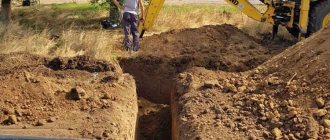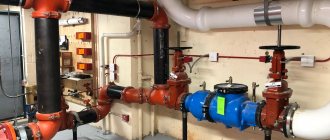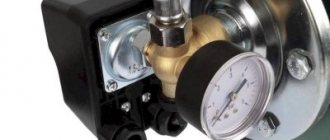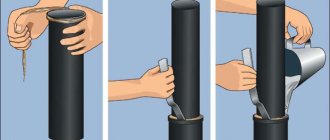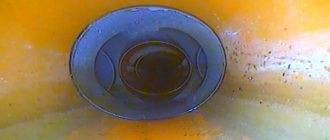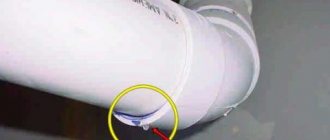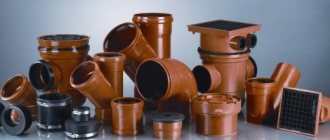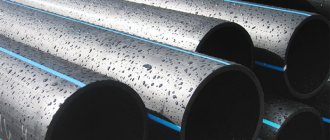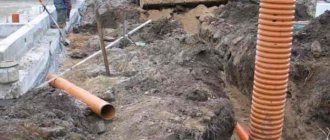Laying pipes in a trench
External pipeline water supply systems can be installed from almost all types of existing pipes. Naturally, their installation is carried out taking into account the specifics of the material from which they are made, since each type of pipe has its own connection methods and its own fittings.
However, when putting water supply pipelines into operation, the systems must meet uniform requirements. What are they, what are the features of pipeline construction, how are they tested and quality controlled? You will find the answer to many pressing questions related to the installation of external water supply networks in our article.
Where to start installing the pipeline?
The construction of the pipeline is preceded by project development. The event is conducted by experienced engineers and is based on research data.
Complete project documentation contains the following information:
- pipe parameters (diameter, length, material of manufacture);
- features of laying the line;
- configuration of supporting structures (if any);
- type of insulating materials for the pipeline;
- specifics of shut-off and metering valves.
If necessary, measures for network maintenance and repair are prescribed. In the case of using steel pipes, anti-corrosion treatment procedures are laid down.
One-pipe method
When creating a single-pipe heating distribution, all its components are connected to each other. They are connected in series into one network. The result is one long pipe.
Typically single-pipe systems are filled with water. The final point where the liquid enters is the radiators. Subsequently, the heat from the heated water is transferred to the premises through the radiators.
The water in the boiler is heated. It then moves through the pipes to enter the radiator. This heating system has several disadvantages. The main disadvantage is that the final radiator is located at a great distance from the boiler, due to which the water in it heats up weakly. This drawback can be eliminated with a small modification of the battery. It should be made with many sections. If you follow these tips, a single-pipe type system becomes much more efficient.
This heating layout for a private house works great if installed in a building with two floors. It's quite simple to explain. If such wiring was installed in a one-story building, we would have to look for a suitable location for the collector. Such an element is necessary for the proper operation of the entire system.
An accelerating manifold is required to speed up the transfer of heat to the radiators. The device allows you to maintain the water temperature at the desired level and reduces the noise level.
The efficiency of operation is directly dependent on the location of the collector. The higher it is, the better. If you have a house with two floors, such problems do not arise - the collector will cope with the task of maintaining heat without creating unnecessary noise.
Other advantages of single-pipe wiring:
- When choosing a single-pipe wiring, you do not have to spend a lot of money. Low cost is ensured due to the small number of pipes.
- Another advantage of this method of heating is the possibility of installation even in the most inaccessible places.
- Simple installation and aesthetics can also be considered among the advantages of installing such a system.
However, this wiring method also has its disadvantages. For example, if you need to replace broken elements, the heating in the house will have to be turned off completely. In addition, heating occurs unevenly. This depends on the distance between the boiler and the distant battery.
However, if the design is modernized and installed correctly, it will turn out to be quite effective. Such a system can be installed in several stages. You can do the work yourself.
What goes into installing pipelines?
The following operations accompany the installation of pipeline pipes:
- Digging trenches. When laying a pipeline in the ground, depressions of a given size are formed. Operations are carried out by handymen or construction equipment. The use of the latter is advisable in open areas without communications.
- Installation of supports. Pipelines installed in an open manner are secured using supports. These elements are made of metal or concrete and have a solid foundation. The location and technological features of the structures are specified in the project.
- Clearing the area. The site may contain trees with a developed root system. They interfere with the installation of pipelines and complicate the operation of equipment. Special equipment is used for uprooting and cutting down vegetation.
When organizing pipelines, other operations may be performed depending on the design of the line and the characteristics of its operation.
Isocom News
General information about pipelines.
Pipelines are devices designed to transport gaseous, liquid, and bulk substances. They are tightly connected straight sections of pipes, parts, shut-off valves, instrumentation, supports and hangers, gaskets, seals and materials that are used for thermal and anti-corrosion insulation.
Technological pipelines are pipelines of industrial organizations through which transportation takes place: semi-finished products, raw materials, steam, water, fuel, production waste, etc.
The complexity of manufacturing and installation of process pipelines lies in:
- the nature of the aggressiveness of the transported substances (water, gas, steam, oil, alcohol, acids, alkalis, etc.);
- equipment configurations, availability and number of connections, compensators, instrumentation, supporting structures;
- the nature of the location of pipelines: trenches, channels, overpasses, shelves, as well as in conditions and heights that are inconvenient for work.
Pipeline installation technology includes the following operations: laying out the pipeline route; installation of supports and suspensions; enlarged assembly of units and blocks; laying, assembly and welding of the pipeline; installation of compensators, fittings, drainage devices, control and automation devices; testing of finished lines, delivery to the customer.
1. Layout of the pipeline route
This process consists of transferring the axes and pipeline marks to the installation site and marking the installation locations of supports and fasteners, compensators and fittings. Layout is carried out using a string, a plumb line, steel tapes, rulers, squares, templates, a theodolite, a level and a hydraulic level. The process is carried out according to installation drawings, which indicate the connections of the pipeline axes to the floors, walls and columns, marks and slopes.
2. Installation of supports and hangers
When installing supports and hangers, it is important to take into account the movement of pipelines due to thermal expansion. During assembly, they must be shifted by an amount from the center of the support in the direction opposite to the extension. Pipeline suspension rods that do not have thermal movements are installed only vertically, and those that have temperature movements are installed inclined. Thermal elongation of pipelines occurs in the direction opposite to the nearest fixed support. The direction of pipeline extension should not be taken as the direction of movement of the product, because these two movements are not related to each other.
3. Integrated assembly of units and blocks
The larger assembly of pipeline blocks is carried out on rigid racks, and sometimes on a site whose surface is concreted or compacted. Assembly sites are usually located near the object being assembled within the range of the installation crane. Enlargement into blocks outside the area of the installation crane is difficult, as it causes problems with loading and transporting the blocks to the installation site, which often leads to the need to reduce their possible dimensions and weight. Before enlarged assembly, temporary plugs and plugs are removed from parts, elements and assemblies of pipelines, which protect their ends from contamination during storage and transportation. In addition, when enlarging the parts, they are degreased and blown, and they are also carefully checked for foreign objects inside the elements and assemblies. The assembly of units into blocks is carried out after control measurements of the finished units and the construction dimensions of the building in the places where the blocks are installed. If necessary, allowances are then cut off on the units and elements or, conversely, pipes are welded. During assembly, all flange connections must be fully tightened with the gasket installed, and welded joints must be welded before the blocks are lifted into the designed position. During assembly, the correct relative position of the joined elements must be recorded.
4. Pipeline assembly and welding
Before assembly and welding, the pipes are completely cleared of soil and dirt, and the shape of the edges is checked. The straightened ends of the pipes must match during assembly. Ellipse at the end, dents and nicks should not exceed the values allowed by GOST for the supplied pipes.
When arc welding, the edges and adjacent internal and external surfaces must be cleaned to a metallic shine to a width of at least 10 mm. The displacement of the edges during welding should not exceed 20% of the wall thickness and should not be more than 3 mm.
The pipes are joined using centralizers, jacks and other devices that ensure mutual alignment of the edges. Pipe joints during arc welding are fixed with tacks.
In any case, the number of tacks must be at least three, their length must be 60-80 mm, thickness - at least 4 mm. Joints of welded pipes with one-sided longitudinal straight seams are assembled so that these seams are offset relative to each other by at least 100 mm. Double-sided longitudinal and spiral seams may not be displaced.
After installation of compensators, fittings, drainage devices, control and automation devices, the finished pipeline lines are tested and handed over to the client.
Pipeline installation cost
The cost of laying a pipeline depends on many factors:
- parameters of the pipes used;
- network length;
- number of bends, metering devices, valves, taps;
- the need for subsequent distribution of the highway within a private or industrial facility;
- additional operations prior to installation;
- the need to remove garbage;
- climatic or other difficulties that increase the load on equipment and personnel;
- urgency of work;
- carrying out installation activities in critical and dangerous areas;
- remoteness of the object;
- special requirements from the customer or industry regulations.
The price for laying a pipeline is specified in the contract between the client and the contractor. The document reflects the terms of cooperation and regulates the rights and obligations of the parties.
Pipe selection
Experience shows that polypropylene pipes are best suited for these purposes, which:
- dampen water hammer well;
- have little resistance to water movement;
- do not need thermal insulation;
- cheap and durable;
- easy to install.
However, they also have disadvantages:
- reinforced polyethylene cannot be used in networks with a coolant temperature greater than 95 °C;
- PPS plastic can withstand temperatures up to 110 °C, but is expensive.
Photo 3. Polypropylene pipes in the heating system, they do not require insulation and are easy to install.
Metal-plastic pipes work well at high temperatures. But their connection is made using metal fittings, which greatly reduce the effective clearance of the pipes. As a result, resistance to water movement in the system increases.
Attention! Pipe and fitting joints are very vulnerable to leakage and must be inspected periodically. Steel ones withstand high temperatures well, but for installation they require the use of welding and a powerful pipe bender, which is not always available when doing the work on your own
In addition, steel is easily susceptible to corrosion, which over time leads to a decrease in the bore diameter of the system and a decrease in its efficiency.
Steel ones withstand high temperatures well, but for installation they require the use of welding and a powerful pipe bender, which is not always available when doing the work on your own. In addition, steel is easily susceptible to corrosion, which over time leads to a decrease in the bore diameter of the system and a decrease in its efficiency.
Copper pipes do not have this drawback, but are very expensive, which has led to their rare use for creating heating systems.
Order pipeline installation
EcoMontazh lays pipelines of various configurations. Accepts applications from individuals and commercial organizations, installs lines for transporting water, coolants, and mild and moderately aggressive media.
The company uses its own technology. This guarantees a prompt solution to the assigned tasks and eliminates the need to use rented cars.
Qualified specialists are responsible for carrying out installation operations on pipelines. They provide a hermetic connection of components, connect bends, plugs, shut-off and metering valves. The quality of work is checked by Quality Control Department employees.
To fill out an application, contact the manager by phone, e-mail or chat.
He will talk about the features of cooperation and offer profitable solutions. Get specialist advice
Requirements for the arrangement of external water supply and sewerage networks
The rules for laying and connecting pipes are regulated by SNiP 2.4.2-84/85*
The internal pipeline is always connected to the external water supply network. To supply liquid to the required object, special pumping equipment and pipes are used. Installation work is carried out in accordance with SNiP regulations. An important point is that when laying a pipeline network, the depth of soil freezing is taken into account.
When installing an external system, other requirements are also taken into account:
- Project work. Drawing up a project and drawings, obtaining permission to carry out these works.
- Availability of required documentation from technical supervision.
- Monitoring the quality of hidden work.
- Use of high-quality consumable tools and materials.
When arranging an external water supply and sewerage system, you need to correctly install the network. Damage or violation of the integrity of other communications that are already laid in this area is unacceptable.
Types of external networks are divided into two large groups:
- A local network is necessary to provide water to certain objects; it is designed in the absence of a centralized pipeline.
- A centralized network provides water to entire settlements, cities, etc.
The source of water for local networks is a well. Therefore, in addition to raising water to the surface, you will need to install a surface or submersible pump.
Installation of metal pipes in Moscow
The installation of metal heating system pipelines should be entrusted to real professionals at the stage of selecting pipes and drawing up a wiring plan. You do not need to study the technical features and subtleties of the circuit yourself. The GorMaster service department in Moscow offers you qualified services for the installation of metal pipes!
Why do people choose us?
- Our craftsmen work with high quality products.
- We use modernized equipment. This allows us to ensure high accuracy of the work performed.
- It is possible to provide services on the same day of application.
- We accept applications 24/7, 7 days a week.
- All work is covered by a 1 month warranty.
Where are metal pipes used?
Metal pipes are used everywhere. Fluid substances are transported along them to create collapsible and non-dismountable elements. They are installed in private and multi-storey buildings, factories and any other buildings. Installation of heavy integral structures is carried out using gas and electric arc devices.
The channels of the products carry substances collected in liquid and gaseous form. Depending on the type of substance, there are systems
- Plumbing;
- Steam lines;
- Gas pipelines;
- Pipes for moving gasoline, fuel oil, oil.
They are always coated with some kind of polymer, which, in addition to aesthetics, also performs a useful function. This layer protects the already installed contour well from destruction and other negative consequences. The best type of layer is zinc.
How is the price determined?
Using welding, craftsmen create high-strength joints between system elements. Pipes are connected using various methods. You can find out the final cost of installing metal pipelines after you add up these parameters.
- Material thickness;
- Metal type;
- Total number of seams;
- Location of weld joints.
The cost of laying elements will be lower if specialists must carry out large volumes of welding operations. Joints located at a height or in a place that is not comfortable for the welder increase the time spent on the process.
The level of strength of the entire installation depends on the quality of the metal. Therefore, the qualifications of the worker play a major role during installation work. Modern equipment is also an important indicator that directly affects the price of welding. Popular types of welding are
- Dugovaya. Produced manually, semi-automatically. Experts can do the job using a consumable electrode.
- Acetylene. The substance melts in the area of the connection.
Stages of installing metal pipes
- If necessary, a team of craftsmen carries out excavation work, installing external pipelines.
- Our specialists supply the type of parts you have chosen. At the same time, they install shut-off valves and valves for protection. They install fittings at the joints.
- Carry out welding operations. Bends are installed to the products. They are treated with anti-corrosion compounds. Installers connect the pipes to utility networks.
- Installation of additional equipment is carried out. Create and place compensators. Workers adjust the support and suspension elements and check the system.
To receive the service in Moscow, simply dial the GorMaster service hotline number! You can discuss the details of the work with our manager!
We work in all districts of Moscow
Eastern AO (VAO): Vostochny, Bogorodskoye, Veshnyaki, Eastern Izmailovo, Golyanovo, Ivanovskoye, Izmailovo, Kosino-Ukhtomsky, Metrogorodok, Novogireevo, Novokosino, Perovo, Preobrazhenskoye, Northern Izmailovo, Sokolinaya Gora, Sokolniki Western AO (ZAO): Mozhaisky, Vnukovo, Dorogomilovo, Krylatskoye, Kuntsevo, Novo-Peredelkino, Ochakovo-Matveevskoye, Vernadskogo Avenue, Ramenki, Solntsevo, Troparevo-Nikulino, Filevsky Park, Fili-Davydkovo Zelenograd Autonomous Okrug (ZelAO): Kryukovo, Matushkino and 106 more districts, Savelki, Silino , Staroe Kryukovo Novomoskovsky Autonomous Okrug (NMAO): Vnukovskoye settlement, Voskresenskoye settlement, Desenovskoye settlement, Kokoshkino settlement, Marushkinskoye settlement, Moskovskiy settlement, Mosrentgen settlement, Ryazanovskoye settlement, Sosenskoye settlement, Filimonkovskoye settlement, Shcherbinka settlement Northern Autonomous Okrug (SAO): Begovoy, Beskudnikovsky , Voikovsky, Golovinsky, Dmitrovsky, Left Bank, Molzhaninovsky, Airport, Eastern Degunino, Western Degunino, Koptevo, Sokol, Khovrino, Savelovsky, Timiryazevsky, Khoroshevsky North-Eastern Administrative District (NEAD): Alekseevsky, Altufevsky, Babushkinsky, Butyrsky, Losinoostrovsky, Ostankino, Bibirevo, Lianozovo, Marfino, Maryina Roshcha, Otradnoye, Rostokino, Sviblovo, Northern Medvedkovo, Southern Medvedkovo, Northern, Yaroslavl North-Western Autonomous Okrug (NWAO): Kurkino, Mitino, Pokrovskoye-Streshnevo, Northern Tushino, Strogino, Khoroshevo-Mnevniki, Shchukino , South Tushino Troitsk Autonomous Okrug (TAO): Voronovskoye settlement, Kievsky settlement, Klenovskoye settlement, Krasnopakhorskoye settlement, Mikhailovo-Yartsevskoye settlement, Novofedorovskoye settlement, Pervomaiskoye settlement, Rogovskoye settlement, Troitsk settlement, Shchapovskoye settlement Central Administrative Okrug (CAO): Basmanny, Krasnoselsky, Meshchansky, Presnensky, Arbat, Zamoskvorechye, Khamovniki, Yakimanka, Tagansky, Tver South-Eastern Autonomous Okrug (SEAD): Nizhny Novgorod, Vykhino-Zhulebino, Kapotnya, Kuzminki, Lefortovo, Lyublino, Maryino, Nekrasovka, Printers, Textile workers, Ryazansky, Yuzhnoportovy Yugo- Western Autonomous District (South-Western Administrative District): Academichesky, Gagarinsky, Lomonosovsky, Obruchevsky, Zyuzino, Konkovo, Kotlovka, Northern Butovo, Tyoply Stan, Cheryomushki, Yuzhnoye Butovo, Yasenevo Southern Administrative District (South-Western Administrative District): Danilovsky, Donskoy, Nagorny, Biryulyovo Eastern, Biryulyovo Western, Brateevo, Zyablikovo, Moskvorechye-Saburovo, Nagatino-Sadovniki, Nagatinsky Zaton, Orekhovo-Borisovo North, Orekhovo-Borisovo South, Tsaritsyno, Chertanovo North, Chertanovo Central, Chertanovo South
Source
Insulation of the water supply system
In order to prevent pipes from freezing and to use the water supply all year round, it is necessary to take measures to insulate it. Materials that are resistant to fire and have low thermal conductivity are used as thermal insulation. If mineral-based fiber insulation is used, the water supply system should be additionally insulated from moisture, otherwise the insulation effect will be reduced to a minimum value. More convenient to use is polystyrene foam, which is produced in the form of shells of two semicircles, treated on the outside with a layer of waterproofing.
Insulation using expanded polystyrene
Particular care should be taken when insulating water pipes at the entrance to the house, since this section is most susceptible to freezing. To avoid such phenomena, in the area from the water supply outlet from the ground to the entry into the house, the pipe is wrapped with a heating cable, and a special sensor is installed to reduce energy costs. It monitors the pipe temperature and turns on the heating system at a critical value.
Prices for laying metal pipes
| Description | Price |
| Departure to your home or office | |
| In case of service provision | for free |
| In case of refusal/transfer | 475 rub. |
| Installation of metal pipes | from 380 rub./m.p. |
| Installation of copper pipes | from 190 rub./m.p. |
| Installation of steel pipes | from 950 rub. |
| Other water supply installation works | |
All craftsmen work under a contract, therefore they bear financial responsibility for the services provided
Professional craftsmen in Moscow work at the prices of our service, and not at their own inflated prices
The cost of work is agreed upon at the diagnostic stage; without approval, work will not begin
We have many specialists, so we can solve the client’s problem within 2-3 hours or whenever it is convenient for him
Pipe material for external water supply and sewerage
HDPE pipes for water supply
Installation of external water supply from polyethylene pipes is the most common today, due to the large number of advantages of the material and the following list of characteristics:
- The size of the outer diameter of the pipe is from 25 mm.
- Operating temperature - up to 40 degrees (low pressure polyethylene pipeline is intended only for cold water).
- The melting point of the substance is about 125 degrees.
- The high ductility of pipes allows them to withstand freezing, along with the water inside, without deformation, tears, etc.
- The material is resistant to corrosion, deposits do not form, therefore, throughput is not reduced. The service life of polyethylene pipes reaches 50 years and above.
- Easy to assemble with compression fittings. It is important that the fittings are in easily accessible places in case of breakdowns, otherwise the pipeline must be welded.
- They can be supplied in the form of individual straight pipes up to 12 meters long or in coils over 50 meters long.
Another advantage is that the material can be supplied up to 1 km long in coils. After all, one of the main features of an external water supply system is the absence of a large number of joints along its entire length. Threaded connections are prohibited.
Using a special welding machine, it is possible to weld individual parts of HDPE pipes.
When installing an external pipeline in a trench, care must be taken to ensure that the pipe lies in one piece. If this cannot be achieved, the parts need to be connected with fittings or welded, and also equipped with an inspection well, which will allow, after repair, if necessary, to monitor the condition of the connections.
Hydraulic testing of water pressure system
To identify shortcomings in the installation of a water supply network from HDPE pipes and check the quality of connections, an inspection is carried out, which is carried out in accordance with SNiP according to the following algorithm:
- the water supply is filled with water without pressure for two hours;
- create pressure that is maintained for 30 minutes;
- carry out a thorough inspection of the pipeline.
Before entering the water supply network, the pipes are washed with clean water until the liquid at the outlet meets hygienic standards.
The construction of an external water supply system from low-pressure polyethylene pipes is a set of technological operations and methods. Careful compliance with the conditions for their implementation and timely monitoring will ensure the functioning of the water supply network of a private home for a long time without additional intervention and repair work.
Source
Pneumatic tests
For testing, compressed air or inert gas is used, which is taken from factory networks or from portable compressors. This option is preferred in cases where hydraulic tests are impossible for a number of reasons: lack of water, very low air temperature, and also when dangerous stresses can arise in the pipeline structure from the weight of water. The value of the maximum test pressure depends on the size of the pipeline:
- for pipe diameters up to 200 mm – 20 kgf/m²;
- 200-500 mm – 12 kgf/m²;
- over 500 mm – 6 kgf/m².
If the pressure limit is different, special test instructions must be developed for such conditions.
Installation of non-metallic networks
The assembly of non-metallic systems has some peculiarities arising from the characteristics of the materials used.
- Polyethylene, polypropylene, PVC and fluoroplastic networks are laid from elements and ready-made units.
- When installing PE and vinyl pipes, make sure that the fittings are securely fixed to the base, and that the steps between maintaining and fastening the gaps from warm types of communications are observed.
- To prevent pipes transporting substances with a temperature of more than +40° from being damaged or sagging, they should be fixed horizontally along the entire length of the network. This is done using gutters and trays made of iron corners.
- For systems with a working environment of less than +40 degrees, it is possible to use metal or fastening brackets and plastic hangers that fit the pipes well.
- When laying pipes horizontally, the fasteners are placed in increments: no more than 150 cm for a network with a nominal diameter of up to 50 mm and no more than 300 cm for analogs with a diameter of more than 50 mm.
- When vertically assembling elements with a length of more than 200 cm, in order to avoid shrinkage under their own weight and the weight of the medium, the fasteners are mounted directly under the shaped socket.
- The instructions note that if the network passes through floors, walls, foundations and other structures, metal cartridges with rounded ends should be installed in these areas.
- The space between the pipe and the sleeve should be filled with a soft sealant.
- The gap between the polymer and hot pipelines should not be less than 10 cm.
- When the network may be damaged during operation, it should be protected with a wooden or iron (solid or mesh) fence.
- If the system transports a medium with a temperature of +60/+90 degrees, it should be laid in a casing made of iron pipes.
- Underground installation of plastic pipelines must be carried out in trays, trenches and channels.
How to dig a trench correctly
After developing the project and purchasing the material, installation of communications begins.
Laying a sewer pipe in the ground begins with digging a trench. Depending on the volume, an excavator is used or excavation work is performed manually with a shovel.
Digging a trench for sewerage
The depth of the ditch is determined by how much the soil freezes in the area. The lower part of the pipeline must be located at a distance of at least 30 cm from the soil freezing line. SNiP P-G.3-62 indicates approximate depth values for laying pipes in a trench: in central Russia it is 2.5-3 meters, in colder regions it is 3.5 meters.
For sewerage installations, in most cases, pipes with a diameter of 110 mm are used. Therefore, the standard trench width is 60 cm. But if the pipes used have a larger cross-section, then the width should be increased.
Attention! A trench for sewerage is dug with a slope of 1-2 cm per 1 linear meter. This is necessary because in private systems there is no pressure pressure, and wastewater moves to the septic tank by gravity.
For the normal functioning of the system, special wells are needed in areas with a sharp bend in the main line or significant differences. This point must also be taken into account when laying a trench.
Cleaning the bottom of the trench
The bottom of the ditch is leveled, the soil is compacted and sand or gravel is poured in a layer of 15 cm.
For the bells, special depressions are made in the ground - pits. A few meters before the inspection well and in the area where the pipeline connects to the inlet pipe, the cushion is compacted. Thus, they prevent soil erosion during heavy rainfall.
Question: If there is not enough space on the site, is it possible to lay pipes for water supply and sewerage in one trench?
Answer: According to regulatory documents (SNiP 3.05.01-85), sewerage and water supply pipes should be laid at a horizontal distance of 1.5 meters from each other. This is if the pipe diameter is no more than 200 mm. If the size is larger, then the distance should be increased to 3 meters.
Theoretically, it is possible to use one trench for laying different pipes if the requirements specified in SNiP are met. In practice, this option is quite difficult to implement. In addition, even the use of plastic pipes does not guarantee that waste water cannot enter the water supply in an emergency.
